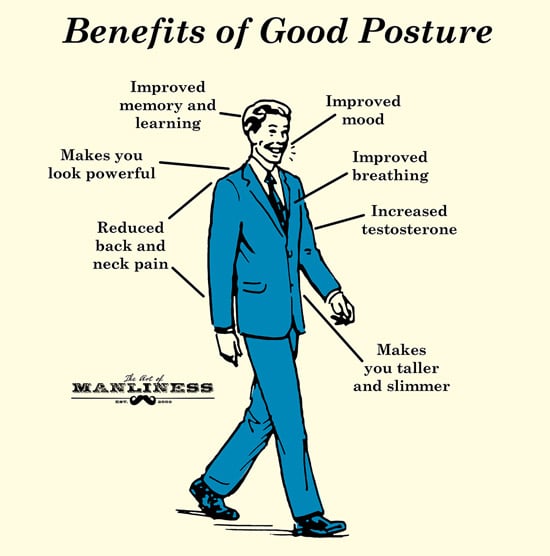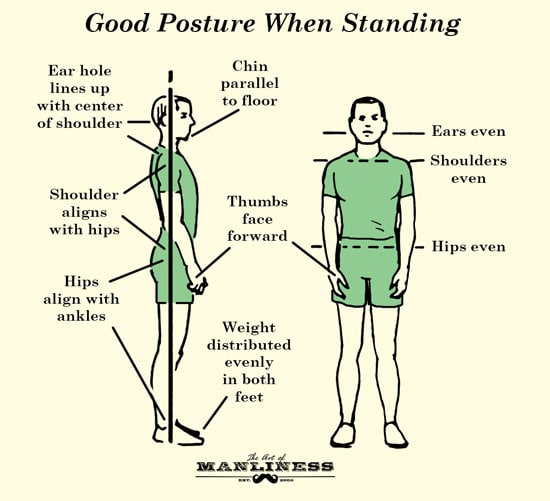One of the most common questions that I receive from my patients is how to attain proper posture. First we must understand what exactly posture is. In simple terms, posture is the relationship with the skeleton to the earth’s gravitational forces. The skeleton is designed to disperse forces from the top of the head, through the feet and eventually to the floor. With a totally “neutral” posture, the body is designed to disperse these forces with minimal impact on the surrounding tissues of the body. But when the posture is altered in any way that alters how the body perceives these forces. This leads to joints of the body taking on more force than they are designed to hold. This is the type of stress that can lead to chronic disease such as disc degeneration, osteoarthritis, chronic low back pain, sciatica, upper back and neck pain, and cervicogenic headaches to name a few. I have written a series of articles with the intent to inform you of how to maintain proper posture throughout your day so you have the knowledge to reduce the load placed on your body and live a healthier lifestyle.
In order to properly understand posture we need to have a baseline to know exactly what proper posture is. We will start by talking about Static Posture, which is your posture when you are standing upright in a still position. Our static posture is the baseline for all of our motions. Static posture is looked at in two planes, the frontal plane (straight on) and the sagittal plane (from the side). Take a look at yourself in the mirror, or even better, have somebody take a picture with you standing with your back to the wall and another picture of you with your shoulder up against the wall to analyze your posture.
When we look from a straight on view there are just a few things to keep in mind. We want to make sure that our head is not tilted from one side or the other. We want to make sure that our shoulders are even along a horizontal plane, and we want to make sure that one hip is not higher than the other.
The more telling of the two views is the sagittal view. This is the view when you are standing with your shoulder up against the wall. In my opinion, this is the easiest and most telling view to analyze. Start by drawing a “plum line” down the center of your body (starting from the center of your head). If you have perfect posture this line should travel through the center of your ear, the point of your shoulder (acromion process), and the point of your hip (greater trochanter), behind your knee cap, and in front of your ankle bone. Now keep in mind that in my time analyzing patients I do not think that I have ever seen anybody with “perfect posture”, so don’t be too hard on yourself!
Now let’s talk about how we can work towards fixing this. There are three points of reference that I want you to focus on. If you can work on getting these three points correct, all the rest will fall into place.
1. Roll Your Shoulders Into The Proper Position
The problem - The first point I want you to focus on is your shoulders. Most often I see patients present with shoulders that are rolled forward. This is likely due to the sedentary and tech-driven way of life that most of our population lives. Anteriority of the shoulders can lead to conditions such as rotator cuff strain, overactive trapezius musculature, adhesive capsulitis, bicipital tendonitis, impingement syndrome, and osteoarthritis (degeneration) of the shoulder.
The Fix – The easy fix to this problem is to roll your shoulders back into a more neutral position, but be careful not to over-roll them. The tip that I give all of my patients is to picture someone in Anatomical Position. Remember your High School anatomy days? I’d say you probably don’t, so I’ll do you a favor and supply you with a picture (above). I want you to stand up nice and straight and try to mimic this gentleman. Notice that his hands are out to the side with his palms facing forward, now make sure when you place your hands like his that your pinky fingers are about even with the seam in your pants. This is proper shoulder positioning! I’m not expecting you to walk around in anatomical position because people will start to look at you funny. So simply use the anatomical position as a means to reset your shoulder posture, and then relax your hands to your side while maintaining your shoulder position.
2. Two Things to Remember With Your Chin
The Problem – Similar to your shoulders, I very commonly see patients present with forward head posture. This is also likely due to all the texting, computer work, etc. that we engage in on a daily basis. Forward head posture puts an amazing amount of stress on the cervico-thoracic junction, which is where the neck meets the back. The rule of thumb here is that for every inch that you hold your head forward, you are adding 10 pounds of pressure to the spine.
The Fix – There are two things to remember with the chin in order to have proper head positioning. The first rule of thumb is that you want your chin parallel with the ground. So if you were to draw an imaginary line straight out from the bottom of your chin, that line should never intersect the floor or the ceiling. The next point of reference is the relationship of the ear to the shoulder. Ideally we want the hole in our ear to lie directly over the point of our shoulder. In most cases, after you level your chin out the ear will fall back in place directly over the point of the shoulder (acromion process). If you notice that the hole in your ear still lies in front of your shoulder, you may need to retract your chin back into the neck. When doing this, make sure that you are retracting and not tilting your chin. Be sure to maintain that parallel relationship between the chin and the ground.
3. Make Sure You Don't Lock Your Knees
The Problem- The knees play an important role in posture throughout the lower half of the body. Very often I see patients with standing with their knees locked. This puts excessive force on the stabilizing ligaments of the knee, primarily the ACL.
The Fix- The fix is very simple. When standing, assure that your knees are not locked and that there is about 5 degrees worth of flexion within the knee joint. This takes pressure off of the ligaments of the knee and allows the forces generated throughout the upper body to be properly transferred through the foot and ankle. Remember what we talked about earlier. When we drawer our posture line from a side view, the line should pass behind the knee and in front of the ankle. This is impossible to accomplish with the knee in a locked position, simply flexing the knee 5 degrees will place the knee in the proper position.
Posture is a very important part of our health and is currently a hot topic in medical research. Studies have shown that poor posture can affect our energy levels, our mood, work productivity, and can lead to a higher frequency of injuries. It is not only important to focus on proper posture in a standing position, but in everything that you do. Throughout this month we will talk about proper seated posture, sleeping posture, desk posture, and tech-posture. Longstanding postural stress can cause damage to the joints of the body, primarily the spine. If you feel as if you are experiencing pain related to poor posture find a Doctor of Chiropractic near you that can remove the restriction and restore mobility, as well as help educate you on proper posture.
Dr. Jesse J. Suess, DC
Suess Family Chiropractic, L.L.C
22 Wyckoff Ave., Suite 1
Waldwick, NJ 07463
(201)972-6121
drjesse@suesschiropractic.com







